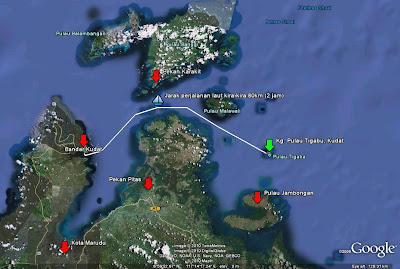Scientist from Naturalis Biodiversity Center Netherlands found ANOTHER gall crab species during fieldwork off Kudat
Think you know the Mother Nature?
Think again! Because across 1 Earth, 7 Continents, 5 Oceans, & 196 Countries,
there always lives an unknown creature . . .
and which is why in this session, we are presenting you
The Discovery of ANOTHER Gall Crab Species in Tun Mustapha Park
 |
| Dr Sancia E.T. Van der Meij during Tun Mustapha Park Expedition Image by Eric Madeja/Treasure Images Sdn Bhd |
Back in 2015, the discovery of the first gall crab species named Lithoscaptus Semperi has uncovered the purity and variety of Tun Mustapha Park (TMP)’s marine biodiversity. It did not take too long for Dr Sancia E.T. Van der Meij to track the inhabitation of Lithoscaptus Tuerkayi, which is another new gall crab species that was found in the outer Northeast reefs of Pulau Banggi - near Kudat, Sabah.
Now give this discovery a round of applause
and we will move on to
Lithoscaptus Tuerkayi at a Glance –
Lithoscaptus Tuerkayi is named after Professor Dr Michael Turkay in recognition of his significant contributions to crustacean research. Relatively, an egg-bearing female holotype of Lithoscaptus Tuerkayi is claimed to be 3.3mm by 2.9mm in size. The gall crab species is white without any visible trace of patterns. According to Fize and Serene (1957 as cited by Van der Meij, 2017), the closest gall crab species to Lithoscaptus Tuerkayi is Lithoscaptus Helleri and subsequently, the newly discovered species is the tenth assigned to the genus Caulastraea. Simply saying, Caulastraea is the host coral that categorised under the large Indo-Pacific coral family Merulinidae.
 |
| Newly discovered Gall Crab - Lithoscaptus Tuerkayi Image Source: Dr Sancia E.T. Van der Meij |
A Call to Action
Since the first discovery of gall crab species – Lithoscaptus Semperi, Dr Robecca Jumin, Head of Marine, WWF-Malaysia has been reaffirming the necessity and urgency to protect our coral reefs for fisheries, food security as well as biodiversity as a whole. That is, regardless of whether you are a direct or indirect dependent of marine resources, let's take a stand in the protection of marine biodiversity for the long-term interest of the future generations!
-- END --
Acknowledgement:
Many thanks to the joint efforts from WWF-Malaysia, Universiti Malaysia Sabah (UMS), Sabah Parks and Naturalis Biodiversity Center for the organisation of the Tun Mustapha Park Expedition (TMPE), which is honorably funded by the Ministry of Science, Technology and Innovation (MOSTI) and USAID Coral Triangle Support Partnership (CTSP). The finding is said to be a milestone that highlights the importance of scientific research advancement in Malaysia, in which making it a significant consideration of management after the TMP was gazetted in 2016.
Written by Chloe Lim.
Edited by Kimberly Chung.
Written by Chloe Lim.
Edited by Kimberly Chung.






Comments
Post a Comment